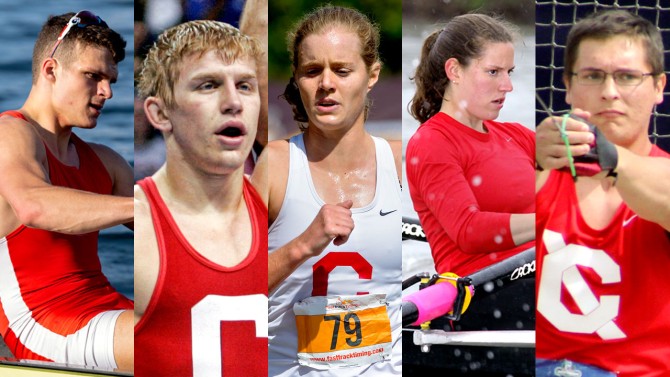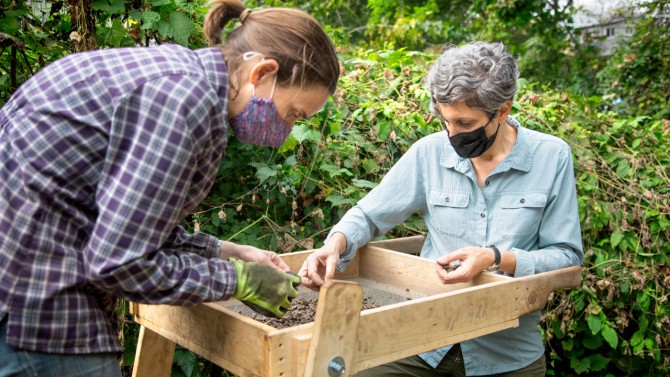Take a look back on everything that Cornellian's have accomplished throughout 2021.
Microscopy world record tops Chronicle’s most-read in ’21
By Tom Fleischman
In 2020, four of the five most-read stories in the Cornell Chronicle related to the pandemic. This year, as of Dec. 1, there was just one COVID-19 story in the top 20 – a reflection of the “new normal” following a year like no other.
Of the top 10 Chronicle stories in 2021, five were on research, one reported on a major gift to the university and two profiled Cornellians doing extraordinary things – including a graduate who played a key role in NASA’s landing of the Perseverance rover on Mars.
The one pandemic-related story in the top 20 was on Weill Cornell Medicine research on vaccination and pregnant women. That came in at No. 17, with nearly 11,000 page views.
The Chronicle publishes approximately 1,500 stories in a year online, and in daily and weekly newsletters. As Cornell’s official news hub, the Chronicle shares major administrative announcements, groundbreaking research, student achievements and campus happenings, and documents the university’s impact on the city, state, nation and world. Here is a rundown of the past 12 months’ most popular stories, according to Google Analytics data.
Top stories
Amazing inquiry on a nanoscopic scale topped all stories in 2021 after Engineering researchers, led by David Muller, set a world record by tripling the resolution of a state-of-the-art electron microscope. “This doesn’t just set a new record,” said Muller, the Samuel B. Eckert Professor of Engineering. “It’s reached a regime which is effectively going to be an ultimate limit for resolution. We basically can now figure out where the atoms are in a very easy way.”
That story, from May 20, has attracted (so far) more than 126,700 page views; more than half of those views likely came on May 22, when the Chronicle site had more than 76,000 page views – at least seven times higher than usual.
Philanthropy for Cornell’s world-renowned hotel school placed second in 2021 when the Chronicle announced a landmark $50 million gift that established the Peter and Stephanie Nolan School of Hotel Administration. The gift will provide scholarship funding to expand educational access for future generations of hospitality business leaders. The Nolan story has drawn more than 52,400 page views since its posting on Sept. 17.
The third most-read story, with more than 35,000 views, is one of four in the top 20 related to sustainability, a major priority at Cornell. The article, from mid-October, reported that more than 99.9% of peer-reviewed scientific papers agree that climate change is mainly caused by humans, according to research co-authored by Benjamin Houlton, the Ronald P. Lynch Dean of the College of Agriculture and Life Sciences.
The other sustainability-related stories in 2021's top 20:
- research led by Lynden Archer, the Joseph Silbert Dean of Engineering, exploring the use of low-cost materials to create rechargeable batteries that will make energy storage safer and more affordable, which came in at No. 7 with more than 14,000 views;
- research co-led by Robert Howarth, professor in the CALS, explaining why “blue” hydrogen might actually be more harmful to the environment than certain fossil fuels (No. 13, nearly 13,000 views); and
- news of a $30 million commitment from David R. Atkinson ’60 and Patricia Atkinson to name a new multidisciplinary building on campus, intended to foster innovative and collaborative research in several priority areas, including sustainability (No. 14, 12,000-plus views). The building will house the Atkinson Center for Sustainability and the new Master of Public Health program, among other entities.
The Nos. 4 and 5 most-read stories on the Chronicle site were both related to campus news – an introduction of the Class of 2025, which reached new levels of diversity and is impressive despite the challenges of the pandemic (more than 31,300 views); and the announcement of residence halls in the North Campus Residential Expansion being named to honor a Nobel Prize winner, a renowned Chinese scholar and the Cayuga Nation, on whose traditional homelands Cornell is located. That story drew nearly 17,000 views.
Two of the remaining stories in the top 10, both of which garnered more than 14,000 page views, featured Cornellians doing amazing things. At No. 6 is a story previewing the five Cornell alumni – Kyle Dake ’13 (wrestling), Tracy Eisser ’12 (rowing), Michael Grady ’19 (rowing), Taylor Knibb ’20 (triathlon) and Rudy Winkler ’17 (track and field) – who went to Tokyo in July for the pandemic-delayed 2020 Summer Olympics. For the record: Knibb won a silver medal in the triathlon mixed relay, and Dake – the Lansing native and four-time NCAA champ – took bronze in 74-kilogram men’s freestyle.
And at No. 9 was the story of NASA aerospace engineer Swati Mohan ’04, who calmly called the “play-by-play” of the Mars 2020 Perseverance rover landing. “Touchdown confirmed” was Mohan’s call at about 3:55 p.m. on Feb. 18. “Perseverance is safely on the surface of Mars, ready to begin seeking the signs of past life.”
The remaining stories in the Chronicle top 10 (Nos. 8 and 10) also collected around 14,000 views and were research-related: an ILR School report stating that internal job applicants who face rejection are nearly twice as likely to leave their organizations as those who were either hired for an internal job or had not applied for a new job at all; and research out of the Charles H. Dyson School of Applied Economics and Management finding that even a slight grocery tax-rate increase could heighten the risk of food insecurity for many.
Other highlights
Other notable stories from the past 12 months:
Lifesaving friendship: ILR School associate professor Adam Seth Litwin spent more than two years secretly improving his health so he could donate a kidney to long-time colleague Ron Ehrenberg. The successful surgery was performed June 29.
Heroes: On a warm March afternoon at Taughannock Falls State Park, three undergraduates – Alexander Chung ’21, Anjan Mani ’23 and Felipe Santamaria ’23 – helped rescue a 62-year-old man who’d fallen into the 40-degree water of Cayuga Lake while fishing off a pier with his two grandsons.
A new way: A study led by College of Veterinary Medicine faculty found that transporting endangered black rhinoceroses upside down by their feet is actually safer than having the tranquilized animals on their sides. The research was awarded a 2021 Ig Nobel Prize, which recognizes improbable research in numerous categories.
New school: A major gift from Jeb E. Brooks, MBA ’70, along with his wife Cherie Wendelken and the Brooks Family Foundation, endowed and named the Cornell Jeb E. Brooks School of Public Policy, advancing the nascent school’s mission to help solve complex global policy challenges. Jeb Brooks is an advocate for socially responsible investment; his late father Earl taught at Cornell.
Deeper: 2021 feature stories in the Chronicle examined the university from different angles. Among them were the story of nine design students who took on the task of creating a design to renovate the old Waterloo Organ Company and turn it into an art center in the upstate village; and the story of a multidisciplinary team of Cornell students and faculty joining community members to conduct an archaeological dig at Ithaca’s St. James A.M.E. Zion Church, the world’s oldest active “freedom church” and a stop on the Underground Railroad.
Notable passings
Harold “Hal” Bierman Jr., the Nicholas H. Noyes Distinguished Professor Emeritus of Management and Finance, who transformed the framing of investment decisions and mentored thousands of MBA students in a 59-year career at Cornell, died Feb. 12 at 96.
Walter LaFeber, the Andrew H. and James S. Tisch Distinguished University Professor Emeritus in the Department of History (A&S), who won ovations from students for classroom lectures and whose mastery of U.S. foreign relations guided historians, political scientists and politicians for decades, died March 9 at 87.
Neil W. Ashcroft, the Horace White Professor of Physics Emeritus (A&S) and a leading theorist in condensed matter physics, whose career experienced something of a rebirth after his official retirement in 2006 when he joined the research group of Nobel laureate chemist Roald Hoffman, died March 15 at 82.
Robert “Bob” Buhrman, M.S. ’69, Ph.D. ’73, Cornell’s second senior vice provost for research, who helped expand Cornell’s emerging science and engineering programs and obtain funding for research, died April 13 at 75.
Arthur “Art” Gensler Jr., B.Arch. ’58, celebrated as a global architect, astute entrepreneur and founder of a small practice that became one of the largest and most successful firms in the industry, died May 10 at 85.
Dr. Alexander de Lahunta, D.V.M. ’58, Ph.D. ’63, emeritus James Law professor of anatomy, considered the founder of veterinary neurology, died Aug. 17 at 88.
Trevor Pinch, the Goldwin Smith Professor of Science & Technology Studies, who helped found multiple areas of study related to science, technology and sound, died Dec. 16 at 69.
Media Contact
Get Cornell news delivered right to your inbox.
Subscribe




